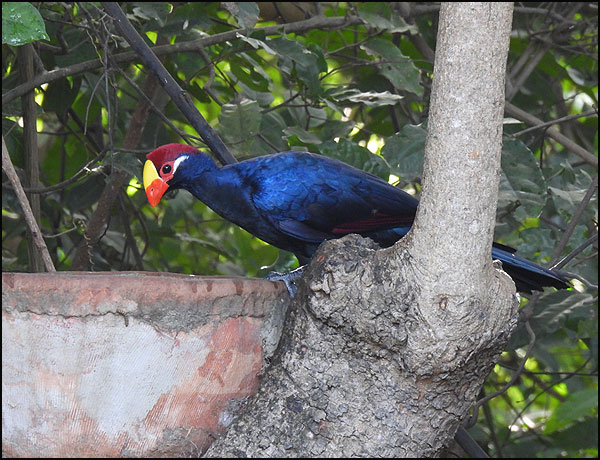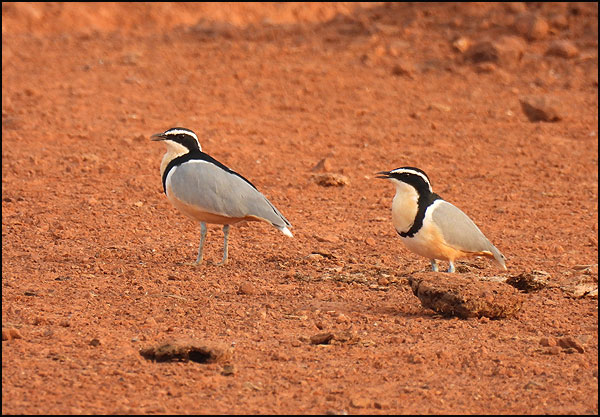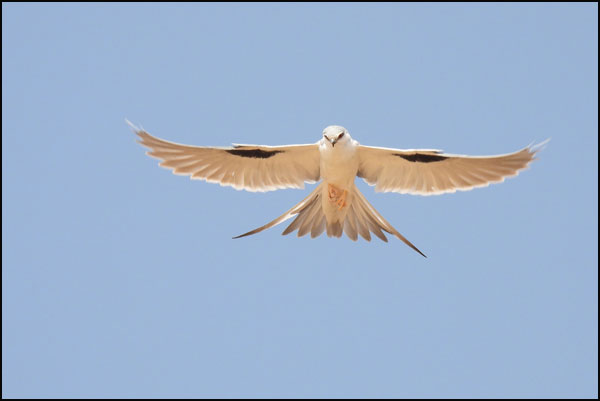When we left the coast we followed the Gambia River east staying at a lodge right on the river before continuing further inland. We crossed the border into the southern part of Senegal, which surrounds Gambia on the north and south, and drove to the southeast corner of Senegal. We stopped at one lodge along the way since this was a long drive and we had the chance of picking up some new birds along the way. We eventually arrived at Niokolo Koba National Park near Wassodou.
We spent two nights here and drove into the national park as well as taking an afternoon boat tour on the Gambia River which flows here. We sighted several kinds of animals including four species of monkeys and a few different antelopes. We also visited two bee-eater nesting colonies where dozens of these colorful birds were nesting in borrows in the river banks and at a sand quarry. We took quite a few pictures of all the birds and animals we could and have a fairly good collection of pictures to remember the trip by. From here we started our drive back toward Dakar.
As we were leaving we had some problems with our guide's van. He stopped for gas and to fill his tires and wanted to fix his car key. His ignition key was loose and he had a hard time starting the van as the key was always slipping into the plastic part of the key so he tried to fix this. He found someone who had some crazy glue but when he opened the key to glue it the chip flew out somewhere on the ground and without it he could not start the van. We spent over three-hours looking for this small chip searching the gravel shoulder of the road and even had a number of people from the town helping but we never did find it. So in the end we had the van towed to a garage and then hired a driver to take us on the last three days of the trip and leaving the van behind. This whole ordeal took six hours of the day which was frustrating for all of us and all because of a small fob chip about the size of a pea. In the end we got it to work out but it also was far more cramped in his truck and not a comfortable ride. We finally arrived at our destination at 8:00 pm after a long day.
At least everything worked out but our guide incurred a big expense and still has to get a new key made and ride all the way back to southwest Senegal to retrieve his van before returning home. We have today and tomorrow at a small guesthouse in town before flying to Morocco where we have two nights before flying from Casablanca to Washington DC and then overnight there before heading to Chicago. So while the trip is mostly over we have several days to go before we are home next Thursday.
We basically finished our bird tour yesterday. We arrived in a town just south of Dakar near the airport. Overall the trip was very successful although the heat was challenging. We ended up with 266 species of birds with some 83 being new on this portion of the trip, plus more than 100 species we saw in Morocco, including 45 new birds there. Quite a few of the birds we saw in Morocco also occur in Senegal and Gambia but altogether we saw over 350 species. I was hoping to boost my list to 4400 but fell a bit short which only means that we need to do another trip somewhere else.


Our guide has been great to travel with. He set up visits to numerous really nice birding sites and also knew dozens of places to stop along the way between sites to search for unusual birds. Of course, he knows nearly all of the birds by voice and is able to identify the many kinds of eagles at an amazing distance. He commonly pointed out birds up to a quarter mile away and while we could see it he would give us the name and then point out the different features that distinguish it. I have to admit that even then it was often hard to see this until the bird came much closer, so he was a real eagle-eye to be with. He also has quite a reputation among the other guides who seem to constantly be asking for his input for their tours. Karanta is always willing to help but said that he keeps a number of his special sites secret from the other guides.
In the evening the temperature would cool into the low 70's to even the upper 60's which felt great when we first got up. By 10:00 it was starting to heat up quickly and by noon to 1:00 it was in the mid to upper 90's. Today it is predicted to hit 100 but we are mostly relaxing at the guesthouse and retreating to our cool room when it gets to be too much. We didn't keep a real close watch on the temp most days but we had a number of days that were around 100 degrees which is fairly normal for this region. When our guide Karanta talked about times of the year or places that he considered hot we made a note of that. What we have is normal temperature around here in equatorial Africa for most of the year except for July to October during the rainy season when it is not only hot but very humid.
Basically, we would start each day birding right after breakfast until about noon or sometimes 1:00 and then eat lunch and take a break. We would go out again between 3:30 and 4:00 pm until about 6:30 and then head back to our lodge wherever we were staying. We always stopped to pick up some cold bottled water during the day and drank that throughout the day to cool down. I don't know if I ever drank so much water in my life but then I haven't spent long times in such high temperatures in quite awhile.

Our friend John and Karanta and our new driver left this morning. We will stay for the day and then head to the airport at 1:00 am for a very early flight to Casablanca where we can rest and see a few sites yet before our flight back. That's about it from Africa for now. It will be quite a change going from the upper 90's to winter weather - both somewhat extreme in opposite ways.
